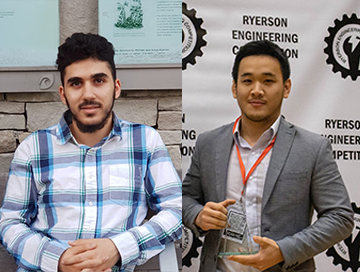FEAS professor and students win ‘Best Robotics Paper’ for their collaborative research

Have you ever wondered how Google Maps formulates directions from point A to point B, or how robotic arms and autonomous vehicles move? The answer is path planning, a computational process that creates a series of accurate configurations to move an object from its origin to its destination.
Assessing the performance of path planning algorithms is an essential part of the development process. Dr. Sajad Saeedi, a mechanical and industrial engineering assistant professor, together with Hussein Ali Jaafar and Bruce Hsueh, students of the Faculty of Engineering and Architectural Science (FEAS), collaborated with researchers from Imperial College London to investigate the topic further. Their project, “PathBench: A Benchmarking Platform for Classical and Learned Path Planning Algorithms”, created a platform for benchmarking these motion planning approaches and won the title of “Best Robotics Paper” at the 18th Conference on Robotics and Vision. The event was held virtually in Burnaby, British Columbia, from May 26-28 of this year.
While Jaafar, a fourth-year mechanical engineering student, and Hsueh, a fourth-year mechatronics engineering student, said the experiential learning opportunity was a reward unto itself, being recognized with the award validated their team's hard work.
“It shows us that bachelor students can also contribute to state-of-the-art research that is deemed useful by the industry and academia,” said Hsueh.
Jaafar and Hsueh knew they wanted to work with Saeedi when it came time to select a research project through the Undergraduate Research Opportunities (URO) program during their third year.
“[Dr. Saeedi’s] research interested me because it was very novel. Machine learning and robotics are always evolving, it's changing very fast, and you have to keep up,” said Jaafar. “It keeps you stimulated and constantly learning.”
The fourth-year students picked up where the original authors of the paper left off and were tasked with platform extension, experimentations, and finalization of the project. Collaboration with researchers, industry professionals, and professors tested their abilities to learn quickly and get up to speed.
“There was a huge gap in terms of our knowledge and skill, so there was a lot of catching up to do,” said Hsueh. “We had to delve into current research in path planning and machine learning while sharpening our engineering fundamentals.”
Despite the challenges they faced while working on the paper, both students' biggest takeaway is the impact that their efforts had on the scientific community.
“Our work and research show what's possible for engineering students or students in general and the impact we could possibly make,” said Hsueh. “You also see what's possible with an engineering degree and how the small changes that we each make can potentially drive the next major engineering innovation or scientific breakthrough.”
“I learned that nothing's too complex, and nothing's too hard,” said Jaafar. “If someone else has done it before, you can do it. And if someone else hasn't done it, then there's your opportunity to do it right. That was something that kept me motivated.”